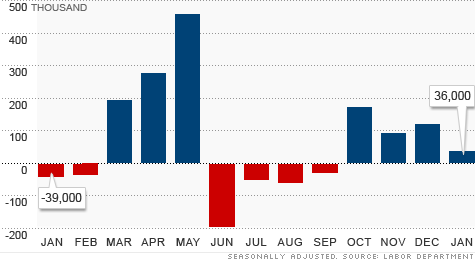Scammer
Banned

-- Winter weather kept job seekers home and offices closed in January, getting the year off to a disappointing start, while the unemployment rate took a surprising tumble.
The economy added just 36,000 jobs in January, falling far short of expectations. Meanwhile, the unemployment rate unexpectedly sunk to 9%, down from 9.4% the month before.
Economists surveyed by CNNMoney were expecting the economy to add 149,000 jobs during the month, and the unemployment rate to rise to 9.5%.
After the report was released, economists weren't quite sure what to make of the numbers, and used a mix of colorful adjectives like "lousy," "mysterious," and "confounding."
But one thing was clear -- weather played a large role in January.
"It's a disappointing employment report, with a touch of skepticism because of the weather's impact on the overall number," said John Silvia, chief economist with Wells Fargo.
Major storms across large swaths of the country had a huge impact on businesses. According to the Labor Department's household survey, which calculates the unemployment rate, severe winter weather kept 886,000 people from going to work during the week of January 9.
All those snow days kept a lot of companies from hiring, said economist John Canally with LPL Financial. It's possible that nasty weather could have reduced the overall payroll number by about 100,000, he said.
The Labor Department also announced that job growth last year was weaker than originally stated. After 2010 revisions, there were about 900,000 jobs created during the year -- 215,000 fewer than previously reported.
The labor market typically needs at least 300,000 job gains each month to make a difference in the unemployment rate, economists say, and at least 150,000 to keep pace with population growth.
Headed in the right direction?
While the sluggish growth to payrolls was disappointing, the drop in unemployment was interpreted in different ways.
Some economists thought it was a result of people dropping out of the labor force, though others pointed to a once-a-year population adjustment based on census data that skewed the numbers.
Almost all of the drop was due to unemployed people finding jobs again, said Zach Pandl, an economist with Nomura Securities.
"This part of the report deserves a positive interpretation," he said.
Overall, the unemployment rate has had its largest two-month decline since 1958, he said.
0:00 /04:30Labor Secretary explains jobs report
The two parts of the report sometimes differ, because they're derived from separate surveys. While the payroll number stems from a survey of employers, the unemployment rate comes from a different survey of American households.
Canally said he expects the job market to show a spike in payrolls in February, and then resume a gradually improving trend. Any improvements though, are still likely to be at a very slow pace.
"People should not be too fearful of losing a job they have," Canally said. "But if they don't already have a job, it's still tough. Companies are still reluctant to hire."
